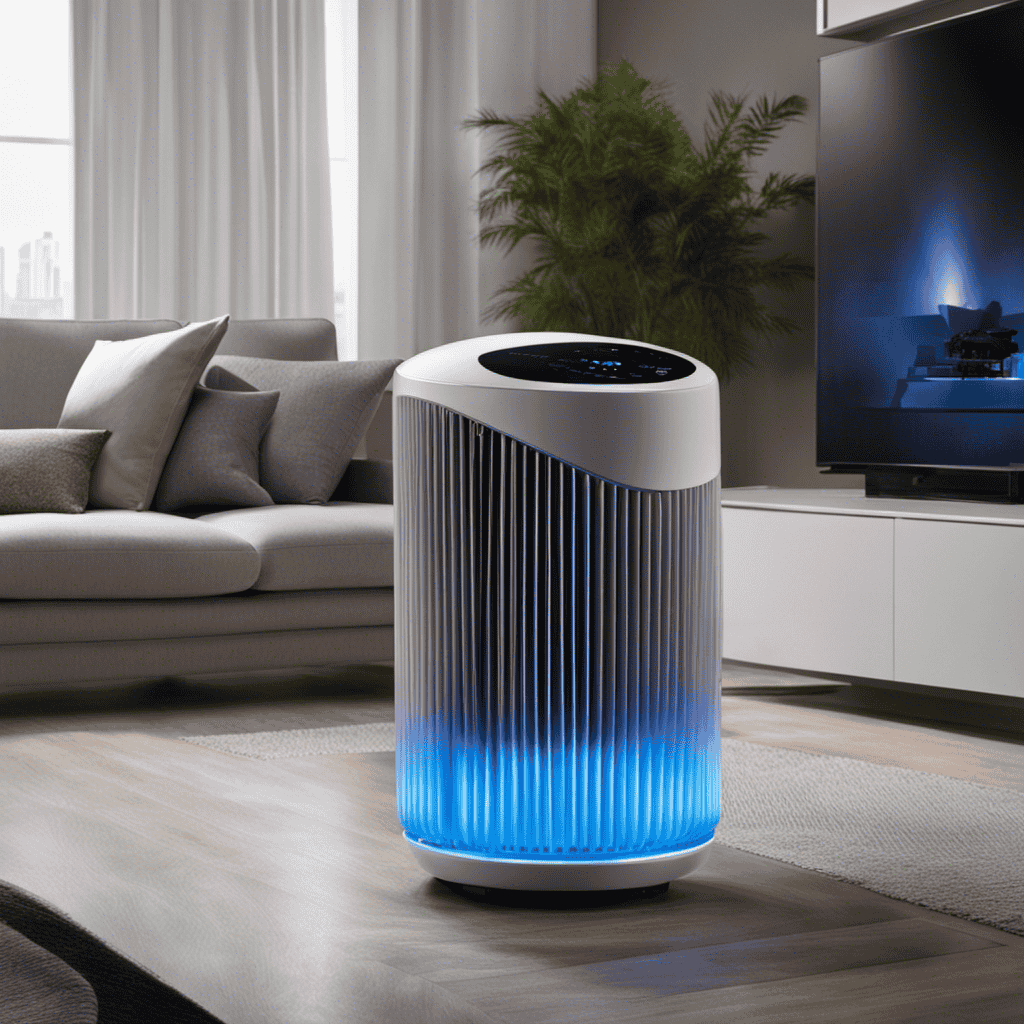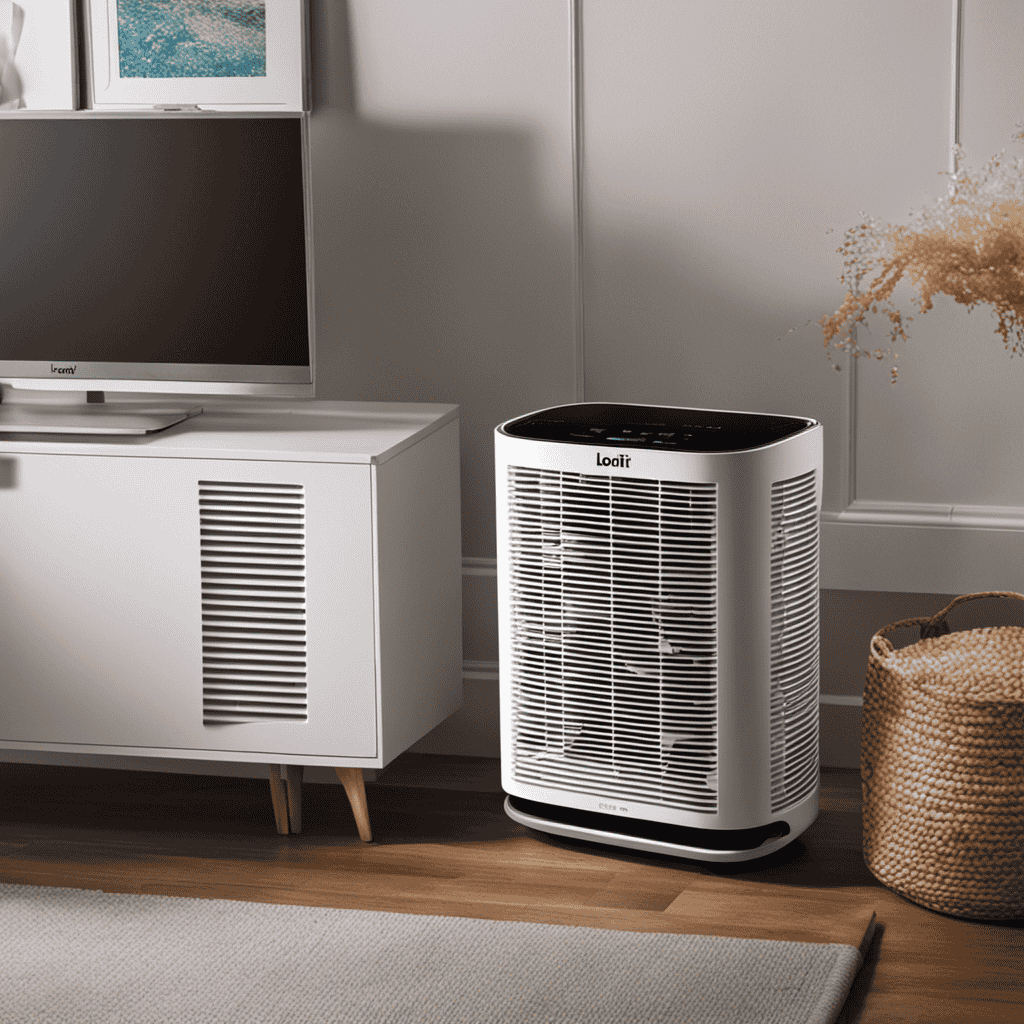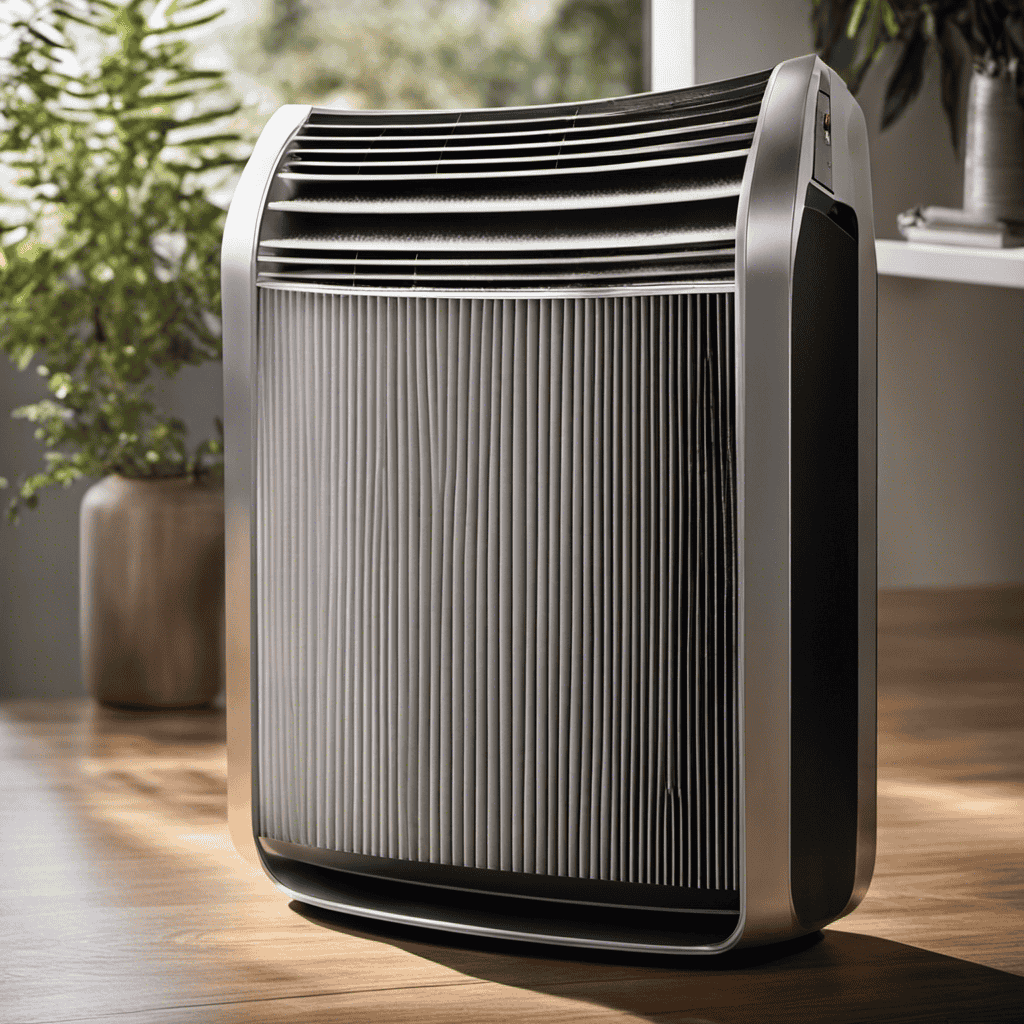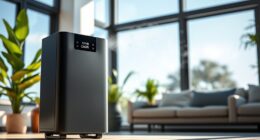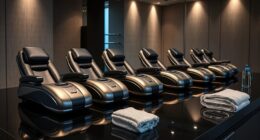I have always been intrigued by the function of UV light in air purifiers. How exactly does it aid in purifying the air? What advantages does it offer and how does it operate?
In this article, we’ll explore the science behind UV light technology in air purifiers, its ability to neutralize odors, and its relationship with allergen reduction. We’ll also discuss the safety measures associated with UV light in air purification systems and what the future holds for this innovative technology.
Let’s delve into the fascinating world of UV light and its impact on air purification.
Key Takeaways
- UV light in air purifiers kills bacteria and viruses, disrupts their DNA and RNA structures, and prevents their replication and spread.
- UV light does not require the use of chemicals or filters, providing a chemical-free and environmentally friendly method of air purification.
- Regular maintenance of UV bulbs is crucial for optimal performance, and their positioning and intensity should be optimized for maximum efficiency.
- Integration of UV light with other purification technologies enhances its effectiveness in providing cleaner and healthier indoor air.
The Role of UV Light in Air Purifiers
UV light is used to kill bacteria and viruses in air purifiers. This innovative technology harnesses the power of ultraviolet radiation to eliminate harmful pathogens from the air we breathe.
The benefits of UV light in air purification are immense. UV light is highly effective in neutralizing microorganisms, including bacteria and viruses, by disrupting their DNA and RNA structures. This prevents them from replicating and spreading, ensuring a healthier and safer environment.
Moreover, UV light technology does not require the use of chemicals or filters, making it a sustainable and cost-effective solution. By incorporating UV light into air purifiers, we can significantly reduce the risk of airborne infections and enhance indoor air quality.
Now, let’s explore how UV light helps in air purification.
How UV Light Helps in Air Purification
When it comes to air purification, UV light plays a crucial role in eliminating germs. By using UV light technology, air purifiers are able to neutralize airborne pathogens, making the air safer to breathe.
Additionally, UV light also helps in reducing odors by breaking down odor-causing molecules, resulting in fresher and cleaner air.
Germ Elimination With UV
Germ elimination is enhanced with the use of UV light on air purifiers. This germ-killing technology utilizes the UV C wavelength, which has proven to be effective in destroying various microorganisms. Here’s how it works:
-
Penetration: UV light emitted from the air purifier can penetrate the cell walls of bacteria, viruses, and other pathogens.
-
DNA damage: Once inside the microorganisms, the UV light causes damage to their DNA, preventing them from replicating and causing harm.
-
Elimination: The damaged DNA disrupts the ability of the germs to survive and reproduce, ultimately leading to their elimination.
Airborne Pathogen Neutralization
Incorporating UV technology into air purifiers significantly enhances their ability to neutralize airborne pathogens. UV light, specifically in the range of 254 nanometers, has been proven to effectively destroy microorganisms by disrupting their DNA, rendering them unable to replicate or cause harm. This technology provides an additional layer of protection against harmful bacteria, viruses, and fungi that may be present in indoor air.
However, it is important to note that regular air purifier maintenance is crucial to ensure optimal performance of the UV light. Dust and debris can accumulate on the UV bulb, reducing its effectiveness over time. Therefore, periodic cleaning and replacement of the UV bulb is necessary to maintain indoor air quality and maximize pathogen neutralization.
Transitioning into the next section, UV technology also plays a significant role in odor reduction.
Odor Reduction Through UV
Using UV technology in air purifiers can effectively reduce and eliminate odors caused by bacteria, viruses, and fungi in indoor spaces. How does this work?
Here are three ways that UV light helps in odor reduction:
-
Air Sterilization: UV light with a specific wavelength, known as UV C, is capable of destroying the DNA and RNA of airborne bacteria, viruses, and fungi. By neutralizing these pathogens, UV light helps eliminate the source of foul odors in the air.
-
Microorganism Inactivation: UV light also disrupts the cellular structure of microorganisms, rendering them unable to reproduce and cause further odor-related issues. This process prevents the growth and proliferation of odor-causing bacteria and fungi.
-
Chemical Decomposition: In addition to neutralizing microorganisms, UV light can break down volatile organic compounds (VOCs) responsible for unpleasant odors. By breaking down these compounds into simpler, odorless molecules, UV light helps remove odors from the air.
Understanding the function of UV light in air purifiers is crucial for maximizing their odor-reducing capabilities and ensuring a clean and fresh indoor environment.
Understanding the Function of UV Light in Air Purifiers
UV light is an essential component in air purifiers due to its ability to kill bacteria and neutralize odors. When air passes through an air purifier equipped with UV light technology, the UV light rays target and destroy bacteria, viruses, and other microorganisms, eliminating potential health hazards.
Additionally, UV light breaks down volatile organic compounds (VOCs) and other odor-causing molecules, effectively neutralizing unpleasant smells in the air.
UV Light Kills Bacteria
Did you know that the UV light on your air purifier effectively kills bacteria? This feature is a result of the UV light’s disinfection and sterilization properties. Here’s how it works:
- UV light penetrates the DNA of bacteria, disrupting its structure and preventing it from reproducing.
- The UV light also damages the bacteria’s proteins and enzymes, rendering them ineffective.
- As a result, the bacteria are unable to survive and multiply, reducing the risk of airborne infections.
Not only does the UV light on your air purifier eliminate bacteria, but it also neutralizes odors caused by them. In the next section, we will explore how UV light achieves this by breaking down volatile organic compounds and other odor-causing molecules.
UV Light Neutralizes Odors
UV light not only kills bacteria in the air, but it also has the ability to neutralize odors. This is one of the many benefits of UV light technology in air purifiers.
When UV light comes into contact with organic compounds, it breaks down their molecular structure, eliminating the source of the odor. This process, known as photolysis, ensures that unpleasant smells are eliminated from the air, leaving it fresh and clean.
UV light technology is highly effective in neutralizing odors caused by smoke, pet dander, cooking, and other sources. By incorporating UV light into air purifiers, manufacturers are able to provide a comprehensive solution for improving indoor air quality, ensuring a healthier and more pleasant environment for everyone.
Benefits of UV Light in Air Filtration
One of the benefits of using UV light in air filtration is its ability to neutralize harmful bacteria and viruses. UV light has strong germicidal properties, making it an effective tool for improving air quality.
Here are three ways UV light helps in air filtration:
-
Inactivating Microorganisms: UV light damages the DNA and RNA of bacteria and viruses, rendering them unable to replicate and causing them to die off. This helps to reduce the spread of airborne diseases.
-
Removing Odors: UV light breaks down volatile organic compounds (VOCs) responsible for unpleasant odors in the air. By neutralizing these compounds, UV light helps to freshen and purify the air.
-
Reducing Allergens: UV light can also eliminate allergens such as mold spores, pollen, and pet dander. By destroying these allergens, UV light helps to alleviate symptoms for those with allergies or respiratory conditions.
Overall, incorporating UV light into air filtration systems can greatly improve air quality by neutralizing harmful microorganisms, removing odors, and reducing allergens.
UV Light Technology in Air Purifiers
Incorporating UV light technology into air purifiers greatly enhances their effectiveness in improving indoor air quality. UV light benefits in air purification have been recognized for many years, but recent advancements in UV light technology have further improved the performance of air purifiers.
UV light works by emitting short-wavelength ultraviolet rays that can effectively kill or deactivate microorganisms such as bacteria, viruses, and mold spores. These harmful particles are often too small to be captured by traditional filters, making UV light an essential addition to air purifiers.
Moreover, UV light technology has evolved to include features such as photocatalytic oxidation, which helps eliminate volatile organic compounds (VOCs) and odors from the air. By combining UV light with other filtration methods, air purifiers can provide cleaner and healthier indoor air for everyone.
The Science Behind UV Light in Air Purification
Recent advancements in technology have improved the performance of air purifiers. These advancements have enhanced their ability to eliminate harmful microorganisms and volatile organic compounds from indoor air. One of the key technologies responsible for this improvement is UV light sterilization. UV light has been proven to be effective in eradicating airborne viruses and bacteria. It does this by destroying their DNA and preventing them from replicating.
Here are three ways in which UV light works in air purifiers:
-
UV-C lamps: Air purifiers equipped with UV-C lamps emit short-wavelength ultraviolet light. This light can penetrate the cell walls of microorganisms, disrupting their genetic material and rendering them inactive.
-
Photocatalytic oxidation: Some air purifiers combine UV light with a photocatalytic filter. When UV light activates the filter, it produces highly reactive molecules. These molecules then break down harmful pollutants.
-
Titanium dioxide coating: Another approach is to coat the air purifier’s components with titanium dioxide. When exposed to UV light, titanium dioxide reacts and produces free radicals. These free radicals safely oxidize and neutralize harmful airborne compounds.
These advancements in UV light technology have greatly improved air purifiers’ ability to create healthier indoor environments. They effectively eradicate airborne viruses and sterilize the air we breathe.
UV Light and Its Impact on Airborne Contaminants
In this discussion, I will explore the effectiveness of germ-killing UV light in air purification systems and its impact on reducing airborne pollutants.
UV light has been widely used as a germicidal agent due to its ability to destroy the DNA and RNA of microorganisms. By incorporating UV technology into air purifiers, it can effectively eliminate harmful pathogens, such as bacteria and viruses, providing a cleaner and healthier indoor environment.
Furthermore, UV light can also help reduce airborne pollutants by breaking down volatile organic compounds (VOCs) and neutralizing odors, ensuring better air quality for occupants.
Germ-Killing UV Effectiveness
You’ll want to know how effective the germ-killing UV light is on your air purifier. Well, let me break it down for you.
UV light technology is designed to target and eliminate harmful germs and bacteria in the air, making it an essential feature for maintaining a clean and healthy environment. Here’s how it works:
-
UV-C Spectrum: The UV light used in air purifiers falls within the UV-C spectrum, which is highly effective at killing germs and microbes.
-
Disruption of DNA: When the UV light comes into contact with these microorganisms, it damages their DNA, preventing them from reproducing and rendering them harmless.
-
Continuous Operation: The UV light operates continuously, ensuring that any airborne germs that pass through the purifier are effectively neutralized.
With the germ-killing effectiveness of UV light, you can have peace of mind knowing that your air purifier is actively reducing the presence of harmful pathogens in your indoor air.
Now, let’s delve into how air purifiers tackle the reduction of airborne pollutants.
Airborne Pollutant Reduction
Now let’s explore how airborne pollutants are effectively reduced by utilizing advanced filtration technology.
One key component of this technology is the use of UV light in air purifiers. UV light, or ultraviolet light, is a type of electromagnetic radiation that has been proven to be effective in killing harmful bacteria, viruses, and other microorganisms.
When airborne pollutants pass through an air purifier equipped with UV light, the UV rays penetrate the cells of these microorganisms, damaging their DNA or RNA and preventing them from reproducing. This significantly reduces the concentration of these pollutants in the air, resulting in cleaner and healthier indoor environments.
In fact, studies have shown that air purifiers with UV light can effectively reduce airborne pollutants by up to 99.9%. Incorporating UV light technology into air purifiers provides an additional layer of purification, enhancing the overall effectiveness of the filtration system.
How UV Light Destroys Germs and Bacteria in Air Purifiers
UV light in air purifiers plays a crucial role in improving indoor air quality by destroying germs and bacteria. Here’s how it works:
-
Irradiation: UV light emits powerful rays that penetrate the cells of germs and bacteria, damaging their DNA or RNA structures.
-
Disruption: This damage disrupts the cellular processes and prevents the microorganisms from reproducing.
-
Inactivation: The UV light effectively kills the germs and bacteria, rendering them inactive and unable to cause harm.
By incorporating UV light technology into air purifiers, the effectiveness of air filtration is significantly enhanced. It provides an additional layer of protection against airborne pathogens, allergens, and other harmful particles.
With UV light, air purifiers can efficiently eliminate these contaminants, ensuring cleaner and healthier indoor air for you and your loved ones.
UV Light as a Defense Against Viruses in Air Purification
Incorporating UV light technology into air purifiers enhances their ability to defend against viruses. UV light, specifically in the UV-C range, has been proven to be effective in killing and inactivating viruses, including the ones causing influenza and COVID-19.
When air passes through an air purifier equipped with UV-C lamps, the UV light alters the genetic material of viruses, preventing them from replicating and causing infection. This mechanism provides an additional layer of protection against airborne pathogens, complementing the filtration and purification processes of the air purifier.
The benefits of UV light in air purification include improved overall air quality, reduced transmission of viruses, and a healthier indoor environment. By harnessing the power of UV light, air purifiers can play a crucial role in preventing the spread of infectious diseases.
Now, let’s explore the effectiveness of UV light in airborne pathogen removal.
Exploring the Effectiveness of UV Light in Airborne Pathogen Removal
UV light is known to have germ-killing properties, making it a promising tool in the elimination of airborne pathogens. By emitting a specific wavelength of light, UV light can penetrate the DNA of microorganisms and disrupt their cellular functions, ultimately leading to their death.
However, the effectiveness of UV light in eliminating airborne pathogens depends on various factors. These factors include the intensity and duration of exposure, as well as the type of microorganism being targeted.
UV Light Kills Germs
Using UV light in air purifiers helps kill germs and bacteria in the air. The disinfection power of UV light is a result of its ability to damage the DNA and RNA of microorganisms, preventing them from reproducing and spreading.
Here are three ways UV light sterilization works:
-
Direct destruction: UV light directly damages the genetic material of microorganisms, making them unable to function and reproduce.
-
Disruption of cellular processes: UV light disrupts vital cellular processes, such as metabolism and protein synthesis, leading to the death of microorganisms.
-
Preventing airborne transmission: UV light in air purifiers eliminates bacteria and viruses in the air, reducing the risk of airborne transmission and contamination.
UV light disinfection is a powerful tool in air purification, as it effectively eliminates harmful microorganisms, ensuring cleaner and safer indoor environments.
Airborne Pathogens Elimination
Eliminating airborne pathogens is essential for maintaining a clean and safe environment indoors. One effective way to achieve this is by using an air purifier.
Air purifiers are designed to remove contaminants from the air, including viruses, bacteria, and other harmful microbes. When it comes to air purifier effectiveness, UV light plays a crucial role. UV light, specifically UV-C light, has been proven to be highly effective in killing pathogens such as bacteria and viruses. This is because UV light damages their DNA, preventing them from reproducing and spreading.
Additionally, UV light also helps in neutralizing odors and reducing allergens in the air. Therefore, incorporating UV light in air purifiers enhances their ability to provide a cleaner and healthier indoor environment.
Effectiveness of UV
To ensure the effectiveness of your air purifier, it’s important to understand how UV light works in killing harmful pathogens. UV light, specifically in the UV-C range, is highly effective in neutralizing bacteria, viruses, and other microorganisms. Here are three key benefits of UV in air filtration:
-
Disinfection: UV-C light damages the DNA and RNA of pathogens, preventing them from reproducing and rendering them harmless.
-
Odor Reduction: UV light can break down volatile organic compounds (VOCs) that contribute to unpleasant odors, improving indoor air quality.
-
Continuous Operation: Unlike filters that can become clogged over time, UV light operates continuously, ensuring constant disinfection without the need for filter replacements.
Understanding the effectiveness of UV light in air purification is crucial for maintaining a clean and healthy indoor environment. Now, let’s explore the role of UV light in preventing mold growth in air purifiers.
UV Light and Its Role in Mold Prevention in Air Purifiers
The UV light on air purifiers helps prevent mold growth. Mold is a common problem in indoor environments and can cause various health issues. Air purification systems with UV light have been designed to combat this problem effectively.
The UV light works by emitting ultraviolet radiation that kills or inhibits the growth of mold spores and other microorganisms in the air. When the air passes through the purifier, the UV light sterilizes the air, eliminating harmful particles and preventing them from spreading. This process helps maintain a cleaner and healthier indoor environment.
UV light technology is a valuable addition to air purifiers, providing an extra layer of protection against mold and enhancing the overall effectiveness of air purification systems.
The Relationship Between UV Light and Allergen Reduction in Air Purifiers
Using UV light in air purifiers can help reduce allergens in the indoor environment. The impact of UV light on allergies is significant, as it has been found to effectively reduce the presence of allergens such as dust mites, pet dander, and pollen.
Here are three ways in which UV light in air purifiers works to reduce allergens:
-
Disruption of allergen DNA: UV light damages the DNA of allergens, rendering them inactive and unable to cause an allergic reaction.
-
Sterilization of air: UV light kills airborne bacteria and viruses, which can trigger allergies in sensitive individuals.
-
Elimination of mold and mildew: UV light inhibits the growth of mold and mildew, which are common allergens and can lead to respiratory issues.
Research has shown the effectiveness of UV light in reducing allergens, making it a valuable addition to air purifiers for allergy sufferers.
UV Light and Its Ability to Neutralize Odors in Air Purification
When considering UV light for odor neutralization, you’ll find that it effectively eliminates unwanted smells in your home. UV light, specifically in the form of germicidal UV-C rays, has the ability to neutralize odors by breaking down the molecular structure of odor-causing compounds.
This process, known as oxidation, occurs when UV light reacts with the organic molecules present in odors, such as bacteria, viruses, and volatile organic compounds (VOCs). UV light sterilization not only eliminates odors but also helps in the elimination of airborne viruses and bacteria.
The high-energy UV-C rays damage the DNA and RNA of these microorganisms, preventing their replication and rendering them inactive. This makes UV light an excellent tool for maintaining indoor air quality and creating a healthier living environment.
Understanding the Safety Measures of UV Light in Air Purifiers
To ensure your safety when using UV light in an air purifier, it’s important to follow the recommended guidelines and precautions. UV light can be effective in neutralizing harmful pathogens and allergens in the air, but it can also pose risks if not used correctly.
Here are three important safety precautions to keep in mind:
-
Wear protective eyewear: UV light can be harmful to your eyes. When operating an air purifier with UV light, always wear protective eyewear to prevent any potential damage to your vision.
-
Limit exposure time: Prolonged exposure to UV light can cause skin irritation and increase the risk of developing skin cancer. Set a timer or refer to the manufacturer’s instructions to ensure you’re not exposed to UV light for an extended period.
-
Keep the air purifier out of reach: If you have children or pets at home, it’s crucial to keep the air purifier with UV light out of their reach. This prevents accidental exposure and reduces the risk of any harm.
The Future of UV Light Technology in Air Purification Systems
If you’re interested in the future of UV light technology, you’ll be excited to learn about the advancements being made in air purification systems. UV light has long been used for sterilization and disinfection purposes, and now it is finding new applications in air purification. The future of UV light technology holds great promise for improving indoor air quality and reducing the spread of airborne diseases.
One of the key advancements in UV light technology is the development of UV-C LED lights, which are more energy-efficient and longer-lasting than traditional UV lamps. These compact and versatile lights can be integrated into air purifiers, providing continuous disinfection of the air. Additionally, advancements in sensor technology allow for real-time monitoring of air quality, ensuring that the purifier operates efficiently.
The following table highlights some of the future applications and advancements in UV light technology in air purification systems:
| Application | Advancement |
|---|---|
| Hospital | Continuous disinfection of patient rooms |
| Office building | Improved air quality for better productivity |
| Schools | Reduction of airborne illnesses |
| Homes | Allergen and pollutant removal |
With ongoing research and development, the future of UV light technology in air purification systems looks promising. These advancements will not only enhance our living and working environments but also contribute to a healthier and safer world.
Frequently Asked Questions
Can UV Light in Air Purifiers Be Harmful to Humans?
UV light in air purifiers can be harmful to humans if not used properly. It is important to follow safety guidelines and avoid direct exposure. UV light is effective in killing bacteria and viruses, improving air quality.
How Long Does It Take for UV Light to Kill Germs and Bacteria in Air Purifiers?
I’ve always wondered how UV light in air purifiers works. Does it really eliminate viruses and mold? I did some research and found out that UV light can kill germs and bacteria, but the effectiveness depends on factors like exposure time and intensity.
Can UV Light Effectively Remove Pet Dander and Allergens From the Air?
UV light in air purifiers is effective at removing pet dander and allergens. The light breaks down the DNA of microorganisms, rendering them inactive. This ensures cleaner air and reduces the risk of allergies and respiratory issues caused by these particles.
Are There Any Potential Risks or Side Effects Associated With Using UV Light in Air Purifiers?
There are potential risks and side effects associated with using UV light in air purifiers. It’s important to consider factors such as exposure time and intensity, as well as the potential for skin and eye irritation.
Are There Any Specific Maintenance Requirements for UV Light in Air Purifiers?
Specific maintenance requirements for UV light in air purifiers include regular cleaning and replacement of the UV lamp, as recommended by the manufacturer. The benefits of using UV light include its ability to kill airborne pathogens and reduce odors.
Conclusion
In conclusion, the use of UV light in air purifiers plays a crucial role in improving indoor air quality. By utilizing this technology, air purifiers are able to effectively eliminate harmful allergens, neutralize odors, and ensure a safer and healthier living environment.
Although some may have concerns about the safety of UV light, it is important to note that modern air purifiers incorporate safety measures to prevent any potential harm.
With advancements in UV light technology, the future of air purification systems looks promising, offering even more efficient and effective results.
